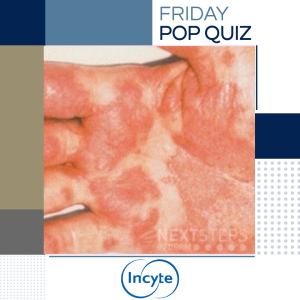
The correct answer is B. About 20% of patients will have a long-term disease that results in enthesitis and destructive arthritis.
The patient has reactive arthritis (formerly known as Reiter’s syndrome). Reactive arthritis is a chronic inflammatory disease similar to psoriasis with psoriatic arthritis and is thought to be a variant form. The classic triad includes urethritis, conjunctivitis, and arthritis. Few patients present with the classic triad, and thus the syndrome can be diagnosed with peripheral arthritis for greater than one-month duration.
Skin findings include keratoderma blenorrhagicum (seen in Image) and circinate balanitis on the penis in men, as well as oral erosions, severe stomatitis, and nail changes. ReA can be self-limiting, recurrent, or continuous, and about 20% to 25% of the patients may progress to have chronic articular, ocular, and cardiac complications. About 20% of patients will have a long-term disease that results in enthesitis and destructive arthritis. Treatments include topical steroids, NSAIDs, methotrexate, acitretin, cyclosporin, and TNF-inhibiting biologics such as etanercept.
In the US, the estimated frequency of ReA is 3.5–5 cases per 100 000 of population. The incidence of ReA after enteric infection is estimated to be 1%–4%. Campylobacter, Salmonella, Shigella or Yersinia spp. are considered common pathogens in the US. In Europe, Yersinia enterocolitica is most commonly associated with ReA, especially in Northern countries, such as Norway or Finland. Similarly, an estimated 1%–3% of all patients with a non-specific urethritis will develop an episode of arthritis. This percentage could actually be higher, since a large number of chlamydial infections remain underdiagnosed or un derreported.
The annual reported incidence of ReA in Europe ranges from 0.9 to 9.3 per 100 000 population and varies greatly from study to study.10,11 In Norway, an annual incidence of 4.6 cases per 100 000 population for chlamydial ReA and an inci dence of five cases per 100 000 population for enteric bacteria induced ReA were reported in 1988–1990. Mycoplasma genita lium has also been rarely associated with the condition as it has been isolated from the joints of patients with ReA, but its true incidence remains unknown. In general, post-venereal ReA is most commonly found in young men, with the peak onset observed during the third decade of life. The male-to-female ratio for post- venereal ReA has been estimated to range from 5 : 1 to 10 : 1. However, post-enteric ReA is equally found in males and females.
Reactive arthritis usually presents 1–4 weeks following a genito urinary or gastrointestinal infection. It most commonly affects young adults aged 20–40 years, and it is quite uncommon in childhood. However, in 10% of patients, the preceding infection may be asymptomatic and the ‘classic triad’ of symptoms, i.e. urethritis, eye disorders and arthritis, is found in only one third of patients.
References: J Eur Acad Dermatol Venereol. 2015 Mar;29(3):415-24.
Reactive arthritis.
Stavropoulos PG, Soura E, Kanelleas A, Katsambas A, Antoniou C. [https://www.ncbi.nlm.nih.gov/pubmed/25199646]; Cheeti A, Chakraborty RK, Ramphul K. Reactive Arthritis. [Updated 2023 Jan 2]. In: StatPearls [Internet]. Treasure Island (FL): StatPearls Publishing; 2023 Jan-. Available from: https://www.ncbi.nlm.nih.gov/books/NBK499831/
